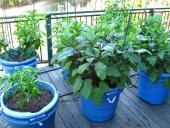
 1
1




 Not sure if it'll solve all my problems but it's certainly going to help.
Not sure if it'll solve all my problems but it's certainly going to help. 5
5




Welcome to the serfdom.
 1
1




Jeff Steez wrote:I imagine the entire garden needs to be watered equally and deeply, rather than the individual plant locations, as the rain does.
I will admit I use a watering can only because I have yet to purchase one of those 100 foot Water Right potable hoses, which are rather pricey. It takes an absolutely absurd amount of jug refills to water the entire garden, so I stagger things by day... trees one day, one section the next.
If the entire bed area isn't watered, the water will wick and dissipate to its surroundings, while the top layer evaporates. Is your soil a lot of peat/loamy substance? When I am making my soil blends peat moss is extremely difficult to wet. Once it's in a pot having been thoroughly wetted, it takes water no problem, which is interesting.
When I transplant anything, I use the dirt that was dug up to create a "ring" around the base of the plant, acting as a barrier or dam. I then water inside that ring, so that the water goes as directly downwards towards the roots as possible, rather than spreading out horizontally. Mulch mulch mulch some more!
Being in Florida, I have since chosen things that barely need water at all besides rain, but that will differentiate from your experience if you want to grow plenty of non-natives.
Perhaps try out some olla watering vessels?

 3
3




Hydrophobic soil is a soil whose particles repel water. The layer of hydrophobicity is commonly found at or a few centimeters below the surface, parallel to the soil profile.
One method of managing water repellent soils is claying. This is done by adding clay materials to the soil, making the overall soil texture have less surface area.
Invasive plants are Earth's way of insisting we notice her medicines. Stephen Herrod Buhner
Everyone learns what works by learning what doesn't work. Stephen Herrod Buhner
 2
2




A build too cool to miss:Mike's GreenhouseA great example:Joseph's Garden
All the soil info you'll ever need:
Redhawk's excellent soil-building series





 1
1




Trace Oswald wrote:I think I would try some manual manipulation as well. Even something like a broom handle with a long nail attached to the end and used to stab some holes would help a great deal to get some water sinking in I think.




In modern times the only right way forward is to come back to nature.
 8
8





 8
8




"When the whole world is running towards a cliff, he who is running in the opposite direction appears to have lost his mind." C.S. Lewis
Visit https://themaineingredient.com for organic, premium dried culinary herbs that are grown, processed, and packaged in the USA.
 3
3




Trace Oswald wrote:I think I would try some manual manipulation as well. Even something like a broom handle with a long nail attached to the end and used to stab some holes would help a great deal to get some water sinking in I think.
"The best fertilizer is the gardener's shadow"
Anonymous Agrarian Blog
 2
2




Moderator, Treatment Free Beekeepers group on Facebook.
https://www.facebook.com/groups/treatmentfreebeekeepers/









When I dug down I discovered - like you - that the soil beneath the mulch layer was bone dry.
"When the whole world is running towards a cliff, he who is running in the opposite direction appears to have lost his mind." C.S. Lewis
Visit https://themaineingredient.com for organic, premium dried culinary herbs that are grown, processed, and packaged in the USA.




Jane Marr wrote:
Edit for added detail: I don't rake, don't til, let native clover run rampant every summer, and own chickens, so the soil shouldn't be lacking in organic matter
Zone 6, 45 inches precipitation, hard clay soil








 1
1




This is all just my opinion based on a flawed memory

 1
1




Ben Zumeta wrote:This is a sign the soil got too dry in the first place most likely, but my first response would be a simple actively aerated compost tea (check out tealab recipes). The natural glues created by the abundant beneficial microbes will help reform hydrophilic soil and particle aggregation. Compost extract wouldn’t hurt either.

|
Because those who mind don't matter and those who matter don't mind - Seuss. Tiny ad:
Learn Permaculture through a little hard work
https://wheaton-labs.com/bootcamp
|





